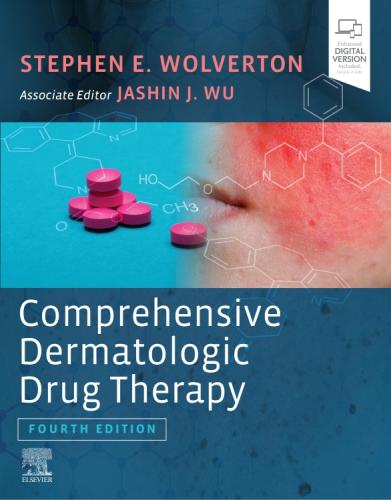Comprehensive Dermatologic Drug Therapy
| Item Information | |
|---|---|
| Item#: | 9780323612111 |
| Edition | 04 |
| Author | Wolverton & Wu |
Designed with practical usability in mind,Comprehensive Dermatologic Drug Therapy, 4th Edition,helps yousafely and effectively treat the skin disorders you're likely to see in your practice. Dr. Stephen E. Wolverton and new associate editor Dr. Jashin J. Wu lead a team of global experts to bring youconcise, complete guidance on today's full spectrum of topical, intralesional, and systemic drugs . You'll prescribe with confidence thanks to expert coverage of which drugs to use, when to use them, and adverse effects to monitor.
Part I: Introduction
1 Basic Principles of Pharmacology
2 Principles for Maximizing the Safety of Dermatologic Drug Therapy
3 Polymorphisms: Why Individual Drug Responses Vary
4 Adherence to Drug Therapy
5 Medical Decision Making
Part II: Important Drug Regulatory Issues
6 The FDA Drug Approval Process
7 Pharmacovigilance: Verifying that Drugs Remain Safe
8 Drugs Taken Off the Market: Important Lessons Learned
Part III: Systemic Drugs for Infectious Diseases
9 Systemic Antibacterial Agents
10 Systemic Antifungal Agents
11 Systemic Antiviral Agents
12 Systemic Antiparasitic Agents
Part IV: Systemic Immunomodulatory Drugs
13 Systemic Corticosteroids
14 Methotrexate
15 Azathioprine
16 Mycophenolates
17 Cyclosporine
18 Phosphodiesterase-4 and Janus Kinase Inhibitors
19 Cytotoxic Agents
20 Dapsone
21 Antimalarial Agents
22 Systemic Retinoids
Part V: Drugs Used in Conjunction with UV or Visible Light
23 Psoralen Plus Ultraviolet A Photochemotherapy and Other Phototherapy Modalities
24 Extracorporeal Photochemotherapy (Photopheresis)
25 Photodynamic Therapy
Part VI: Biologic Therapeutics
26 Tumor Necrosis Factor Inhibitors
27 Interleukin 12/23 Inhibitors
28 Interleukin 17 Inhibitors
29 Interleukin 23 Inhibitors
30 Rituximab
31 Additional Biologic Therapeutics: Dupilumab, Omalizumab, Others
Part VII: Miscellaneous Systemic Drugs
32 Antihistamines
33 Vasoactive and Antiplatelet Agents
34 Antiandrogens and Androgen Inhibitors
35 Psychotropic Agents
36 Intravenous Immunoglobulin Therapy
37 Systemic Anticancer Agents: Dermatologic Indications and Adverse Events
38 Hedgehog Pathway Inhibitors
39 Drugs for the Skinternist
40 Miscellaneous Systemic Drugs
Part VIII: Topical Drugs for Infectious Diseases
41 Topical Antibacterial Agents
42 Topical Antifungal Agents
43 Topical and Intralesional Antiviral Agents
44 Topical Antiparasitic Agents
Part IX: Topical Immunomodulatory Drugs
45 Topical Corticosteroids
46 Topical Retinoids
47 Topical and Intralesional Chemotherapeutic Agents
48 Topical Calcineurin Inhibitors
49 Topical Vitamin D3
Part X: Miscellaneous Topical Drugs
50 Sunscreens
51 Therapeutic Shampoos
52 ?-Hydroxy Acids
53 Chemical Peels
54 Products for the Care of Chronic Wounds
55 Agents Used for Treatment of Hyperkeratosis
56 Irritants and Allergens: When to Suspect Topical Therapeutic Agents
57 Miscellaneous Topical Agents
Part XI: Injectable and Mucosal Routes of Drug Administration
58 Local Anesthetics
59 Injectable Dermal and Subcutaneous Fillers
60 Botulinum Toxin Injections
61 Oral Mucosal Therapeutics
Part XII: Major Adverse Effects From Systemic Drugs
62 Hepatotoxicity of Dermatologic Drug Therapy
63 Hematologic Toxicity of Drug Therapy
64 Drug-induced Malignancy
65 Dermatologic Drugs During Pregnancy and Lactation
66 Drug Interactions
67 Cutaneous Drug Reactions With Systemic Features
Part XIII: Special Pharmacology and Therapeutics Topics
68 Informed Consent and Risk Management
69 Compounding in Dermatology
70 Dermatologic Drug Therapy in Children
Appendix I Core Questions for Understanding Systemic Dermatologic Drugs
Appendix II The Most Potentially Serious Drug Interactions

